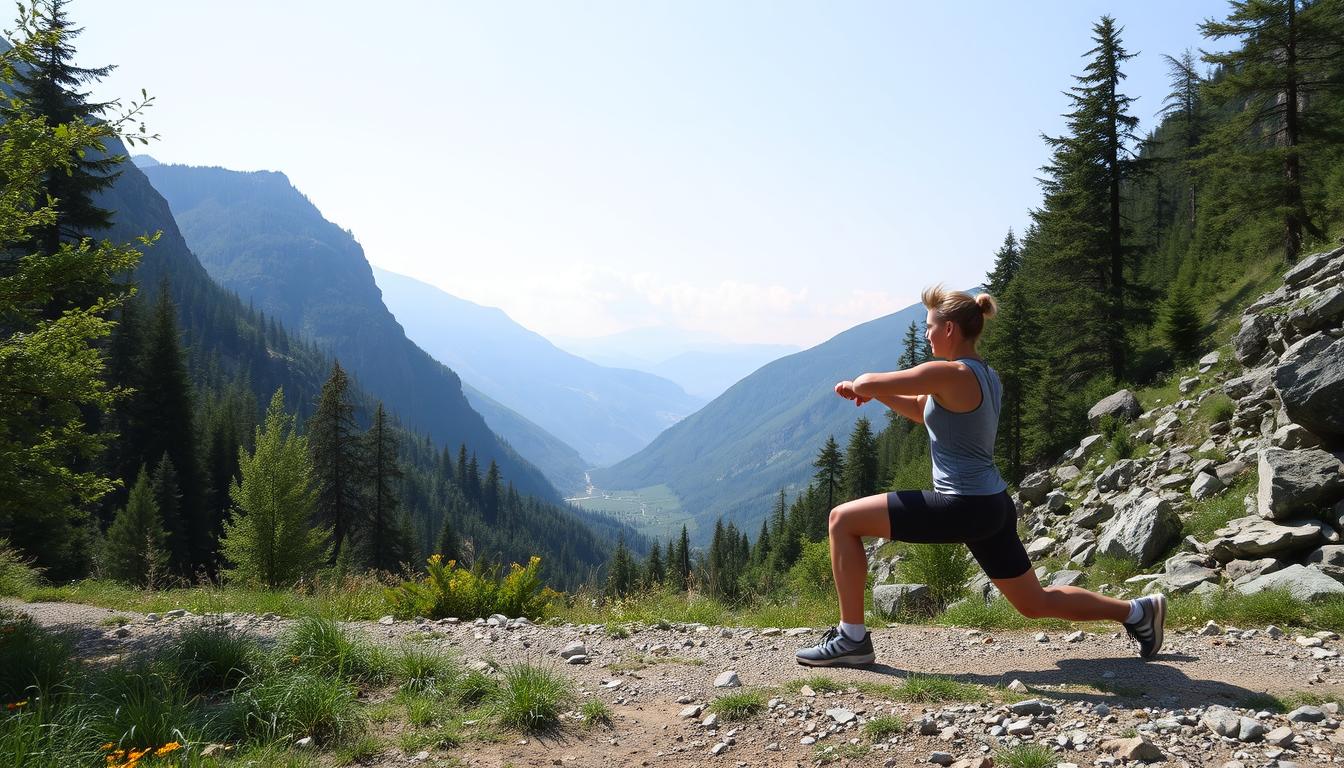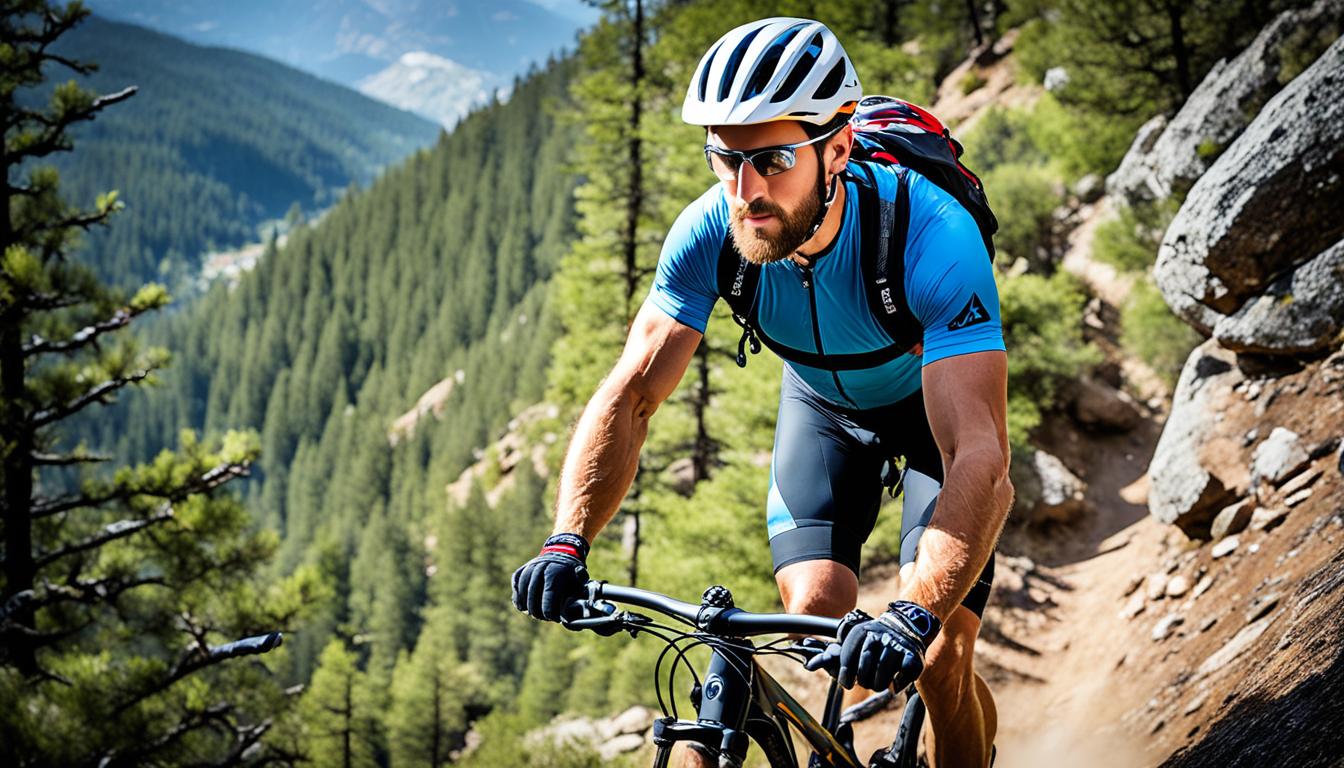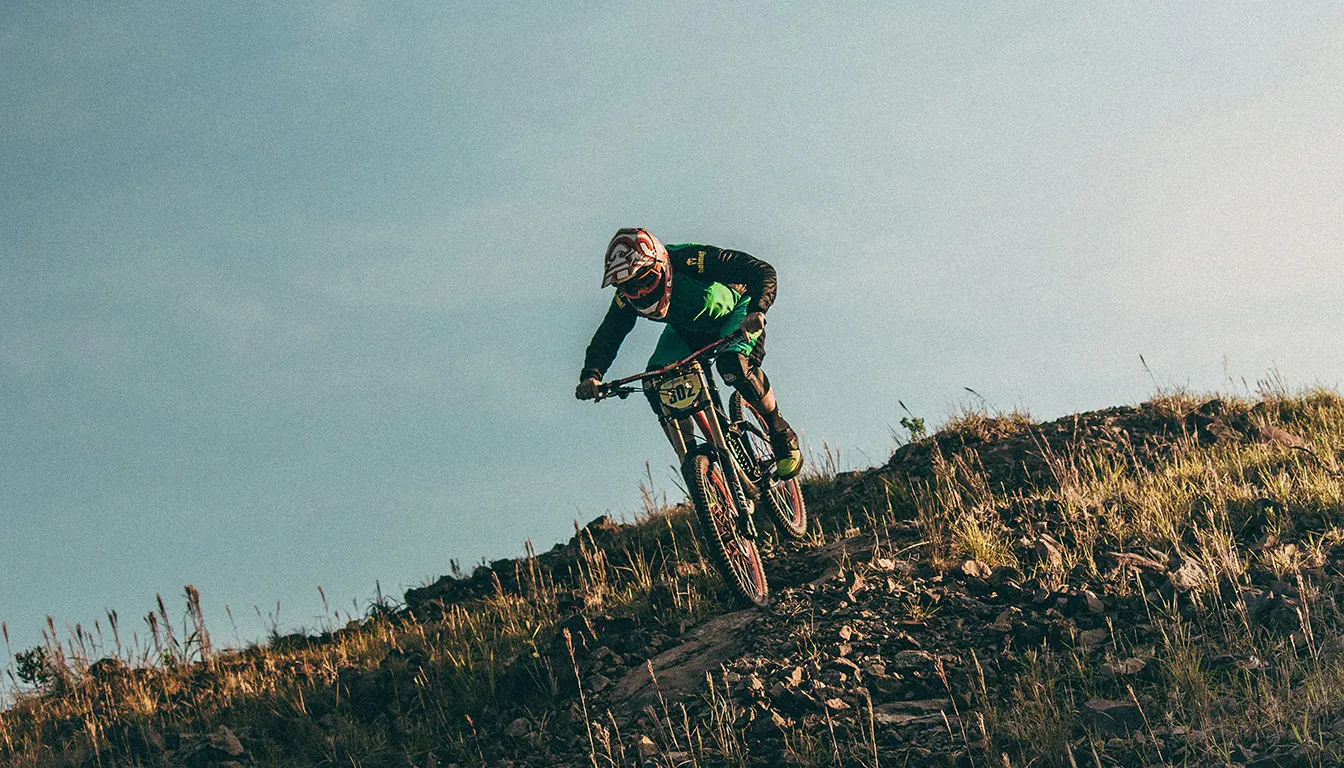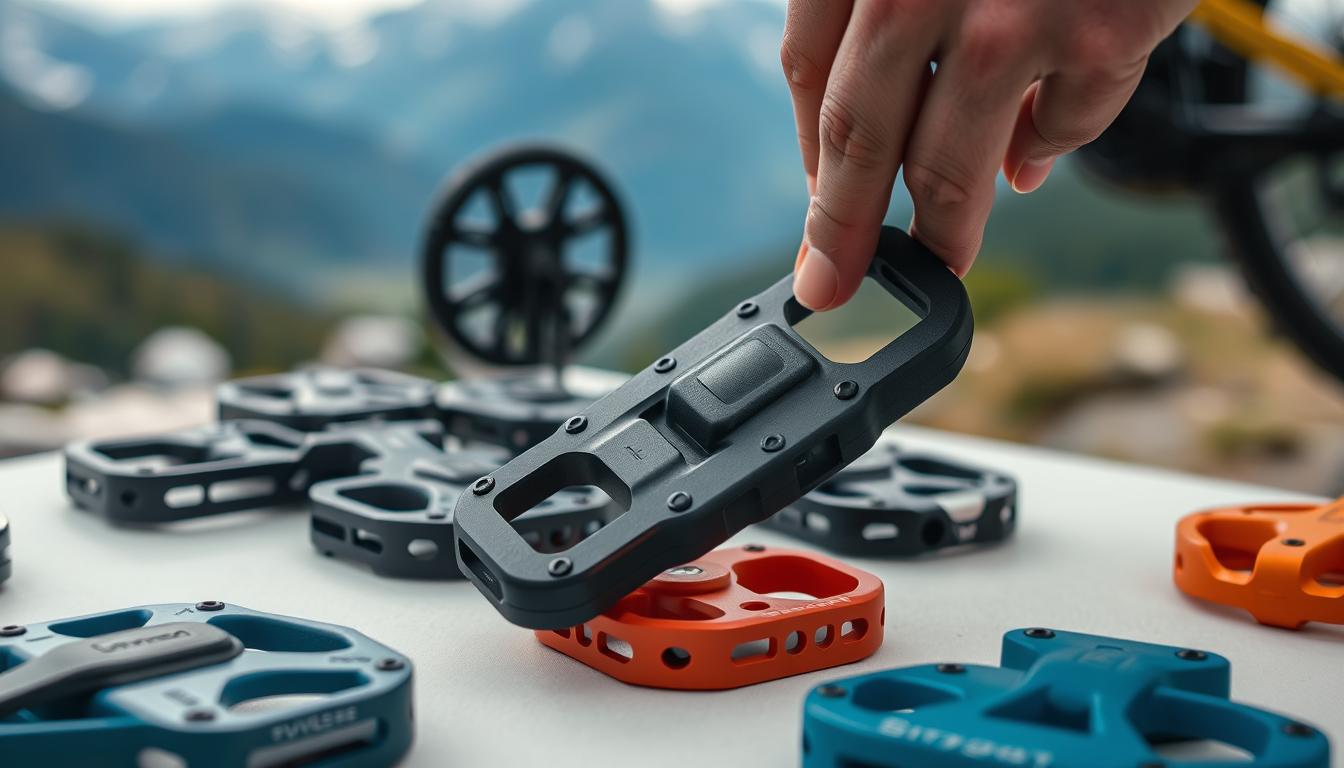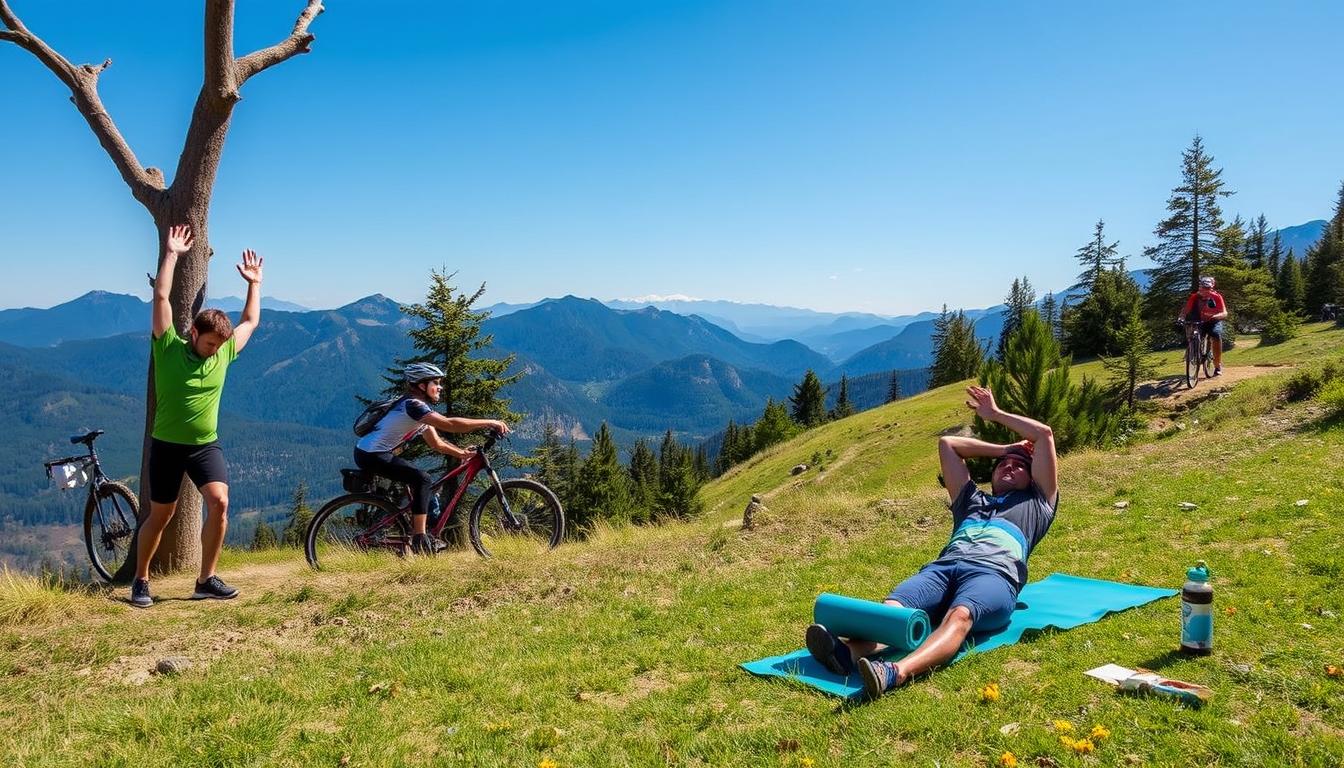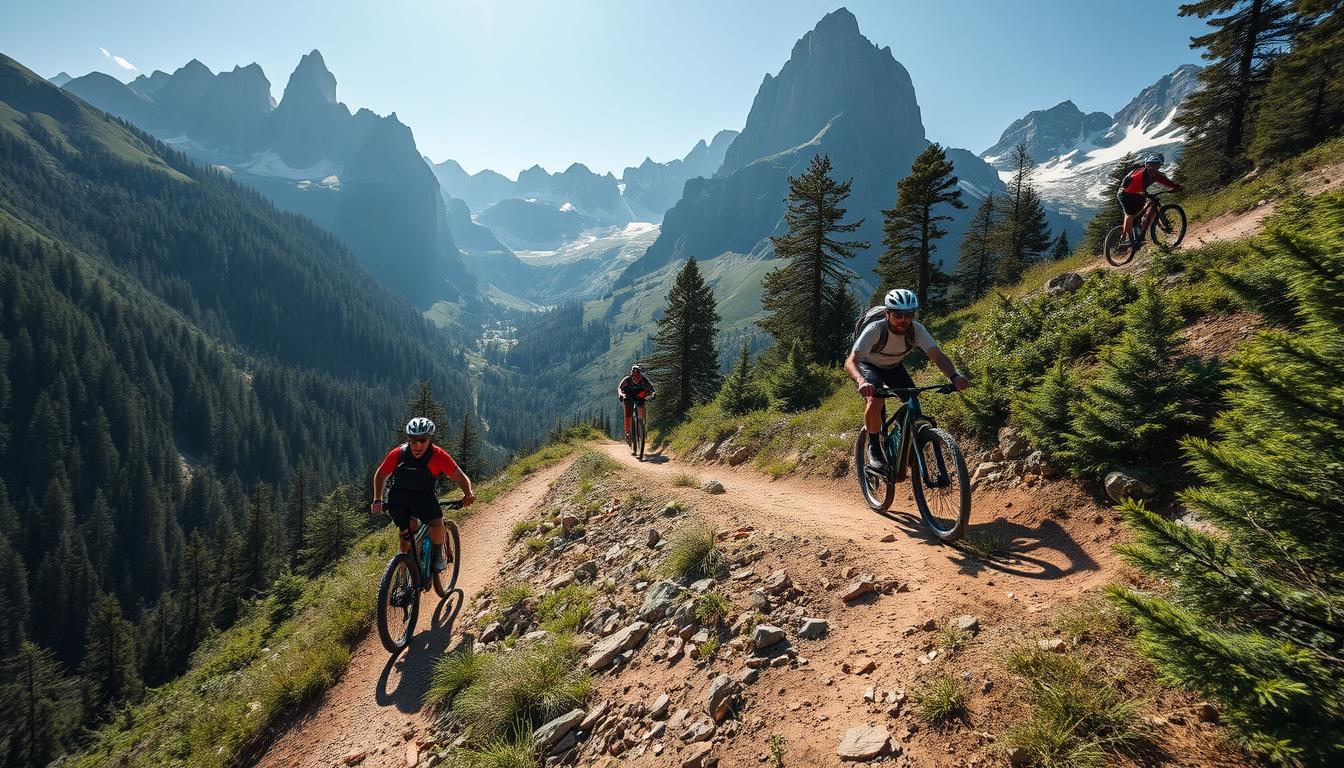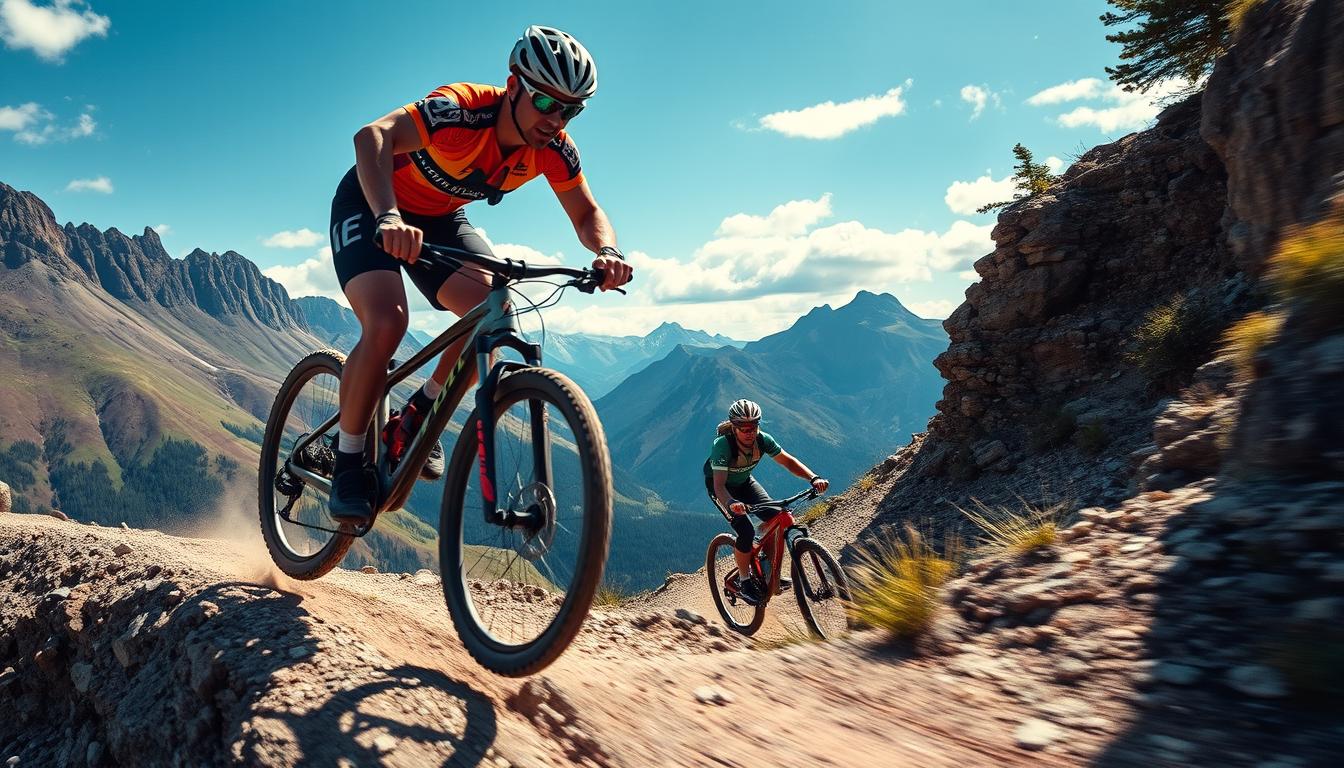For mountain bikers, staying flexible is key to boost performance and stay comfy on rides. Cycling a lot can make your muscles tight, especially in your hips and lower back. This can make you feel sore and less nimble. It’s very important to mix flexibility exercises into your training. This helps fight these problems and betters your time on the bike.
Flexibility matters a lot for mountain bikers, and this article is full of tips. It talks about common flexibility issues and special exercises to up your biking game. By focusing on stretching, you can lower injury risks and feel a lot better while biking.
Understanding the Importance of Flexibility for Mountain Bikers
Mountain biking combines strength, endurance, and flexibility. Flexibility is key for better cycling. It helps with positioning on the bike, boosts pedalling efficiency, and lowers injury risk.
How Flexibility Affects Performance
Flexibility helps riders maintain good positions, especially on rough terrain. Lack of flexibility can cause muscle strain and poor posture. This affects performance. Studies show that stretching can increase flexibility for better riding.
Working on flexibility improves range of motion. This leads to more efficient pedalling and higher power output.
Flexibility vs. Strength: A Balancing Act
Mountain bikers need to balance flexibility and strength. Strength powers your ride, but flexibility ensures movement is unrestricted. Research found that foam rolling and stretching improve flexibility, boosting strength in climbs and sprints.
Focusing on both flexibility and strength prepares cyclists for challenges. It also promotes long-term health. Including yoga can improve flexibility, making rides more balanced and effective. For tips on riding a single speed bike, check out this resource.
Common Flexibility Issues in Cyclists
It’s important to know about common flexibility issues that cyclists face. Many cyclists deal with tight muscles. This can limit movement and affect how well they ride. Often, this tightness is found in the hips, core, and lower back.
Identifying Tight Muscles
Figuring out which muscles are tight is the first step. Look out for stiffness in:
- Quads
- Hip flexors
- Hamstrings
- Lower back
This stiffness can cause poor posture. Bad posture makes flexibility issues worse during cycling. Checking yourself regularly helps find areas that need work.
Impact of Poor Flexibility on Posture and Performance
Lack of flexibility affects a cyclist’s performance in many ways. Tight muscles can change how you sit on the bike. This can lead to stress on the body, discomfort, and sometimes injuries. Problems often start with poorly fitting bikes and not enough training. Adding Pilates and yoga to your routine helps avoid these injuries and keeps muscles balanced.
Recognising and acting on flexibility issues is key to better cycling. For more tips on training and techniques for mountain biking, see this detailed guide.
Mountain Biking Flexibility Exercises
Flexibility exercises are key to better mountain biking performance. They include dynamic and static stretching, each with its own benefits. Before riding, warming up your muscles and joints is important. After riding, stretching helps with recovery and makes you more flexible.
Dynamic Stretching: Preparing for the Ride
Dynamic stretching should be part of your pre-ride routine. It involves movements that are like biking actions. This gets your body ready for what’s coming. Leg swings, arm circles, and torso twists warm you up. They get your blood flowing. Doing these stretches regularly helps with coordination and prepares you for rough trails.
Static Stretching: Post-Ride Recovery Ritual
After riding, it’s crucial to do static stretches. This helps you recover and increases flexibility. By holding stretches, your muscles get a chance to relax and extend. This fights the tightness from biking for a long time. Calf stretches and seated hamstring stretches are good for targeting strained areas. Regularly doing these keeps your muscles healthy and boosts recovery. This improves how you ride over time.
Recommended Flexibility Exercises for Cyclists
Incorporating regular stretching into your routine is crucial for cyclists. It improves performance and prevents injuries. These stretches focus on major muscles used in cycling.
Calf Stretch: Keeping Your Legs Happy
The calf stretch is crucial for lower leg flexibility. It helps avoid tightness that leads to discomfort. Stand with one foot in front of the other. Keep the back heel down and lean into the front leg. Hold it for 20-30 seconds then switch.
Downward Facing Dog: Full-Body Stretch
This yoga pose stretches your whole body. Start on hands and knees. Then lift your hips up and back into an inverted “V”. It eases tension in the back, shoulders, and legs. This is key for cyclists’ flexibility.
Expanded Leg Pose: Perfect for Tight Hamstrings
The expanded leg pose targets the hamstrings. Sit with legs wide and reach towards your feet. Keep your back straight. This stretch improves hamstring flexibility for better pedal power.
Quad Stretch: Counteracting Cycling Posture
The quad stretch helps with cycling-induced tightness. Stand on one leg. Grab your opposite ankle and pull towards your buttock. This stretch helps against the forward cycling posture, promoting better posture on long rides.
When and How to Incorporate These Exercises
Adding flexibility exercises to a cyclist’s routine boosts performance and lowers injury chances. The timing of these exercises is crucial for getting the most out of them. It is important to know the difference between warm-up exercises and post-ride stretches. Each has a special role in a cyclist’s training plan.
Pre-Ride Warm-Up Techniques
Before starting a ride, it’s vital to do the right warm-up. Dynamic stretches help increase blood flow and get muscles ready for cycling. Focus on big muscle groups to improve overall flexibility. Include exercises like:
- Leg swings
- Arm circles
- Walking lunges
- Hip openers
For warm-ups, aim for 10 to 15 minutes. This helps the body smoothly get ready to ride. It helps avoid injuries like strains and sprains.
Post-Ride Stretching Routine
After a ride, stretching is key for recovery. Static stretches are best after heavy exercise. They make muscles longer and more flexible. Try these stretches:
- Cobra stretch for the back
- Seated hamstring stretch
- Child’s pose for relaxation
- Quad stretch to ease tension
Stretch right after cycling for quicker recovery. Do it for at least 10 minutes. Each stretch should last 20 to 30 seconds for the best effect. This helps muscles repair faster and reduces stiffness.
The Long-Term Benefits of Flexibility for Mountain Biking
Flexibility is key in mountain biking for both performance and staying in the game longer. When cyclists stick to flexibility exercises, they see big gains. These include fewer injuries and quicker recovery times.
Injury Prevention through Flexibility
Adding flexibility routines greatly cuts down the chance of getting hurt. Being more flexible helps keep tissues healthy and joints moving easily. This smooth movement is crucial when biking in different positions.
Cyclists can tackle tight muscles, easing pain and avoiding common overuse injuries. Regular stretching also means better posture on the bike. This leads to improved aerodynamics and safety while riding.
Enhanced Recovery and Performance
The perks of being flexible don’t stop at preventing injuries. It also speeds up how fast cyclists recover after rides. Stretching eases muscle soreness and stiffness, making recovery smoother.
Being more flexible means cyclists can push harder and longer. They achieve a larger range of motion and pedal more efficiently. With less pain and tiredness, cyclists can enjoy their rides more and see improved results in races.
Conclusion
Flexibility’s benefits go far beyond just feeling comfortable. They play a big part in improving cycling performance. Through regular stretching, mountain bikers gain more mobility, better balance, and a lower injury risk. Adding different types of stretching, like dynamic and static, boosts riders’ confidence and stamina.
Stretching does more than help the body; it clears the mind, similar to solving tough maths problems. It teaches cyclists to handle challenging paths using varied skills. This shows how flexibility helps cyclists overcame obstacles more efficiently.
A complete stretching plan is key for ongoing success in mountain biking. Understanding the advantages of flexibility lets riders enjoy their sport more, with better performance. Remember, caring for our bodies through stretching means a happier, injury-free cycling journey.
FAQ
Why is flexibility important for mountain bikers?
For mountain bikers, flexibility is key. It boosts performance and helps avoid injuries. Doing regular stretches keeps muscles balanced and posture correct. It also allows bikers to move more freely, making rides smoother and more enjoyable.
What are common flexibility issues faced by cyclists?
Cyclists often deal with tight quads, hamstrings, hip flexors, and lower back. This tightness can spoil posture and affect how well they cycle. Spotting which muscles are tight is the first step to stretching them right.
What types of stretching should cyclists incorporate into their routines?
Adding dynamic stretches before riding and static stretches after is smart. Dynamic stretching gets muscles ready for action. Static stretching helps them relax and stretches them out after a ride.
Can poor flexibility really affect my cycling performance?
Absolutely, poor flexibility can mess with muscle balance and cause discomfort. It can drag down your cycling technique and power. Keeping flexible means you can put out more power and lower injury risk when riding.
What are some recommended flexibility exercises for cyclists?
Some good stretches include the calf stretch, Downward Facing Dog, Expanded Leg Pose, and the Quad Stretch. These help with flexibility in your lower legs, release body tension, improve hamstring flexibility, and tackle tightness from cycling positions.
How often should I stretch to see improvements?
Stretch at least 3-4 times a week to really make a difference. Sticking to stretching routines before and after rides will boost your flexibility and better your cycling performance over time.
What are the long-term benefits of improving flexibility for mountain biking?
Gaining flexibility is great for preventing injuries, speeding up recovery, and lifting your performance levels. It also means better posture, which can help with your bike’s aerodynamics and stability.
